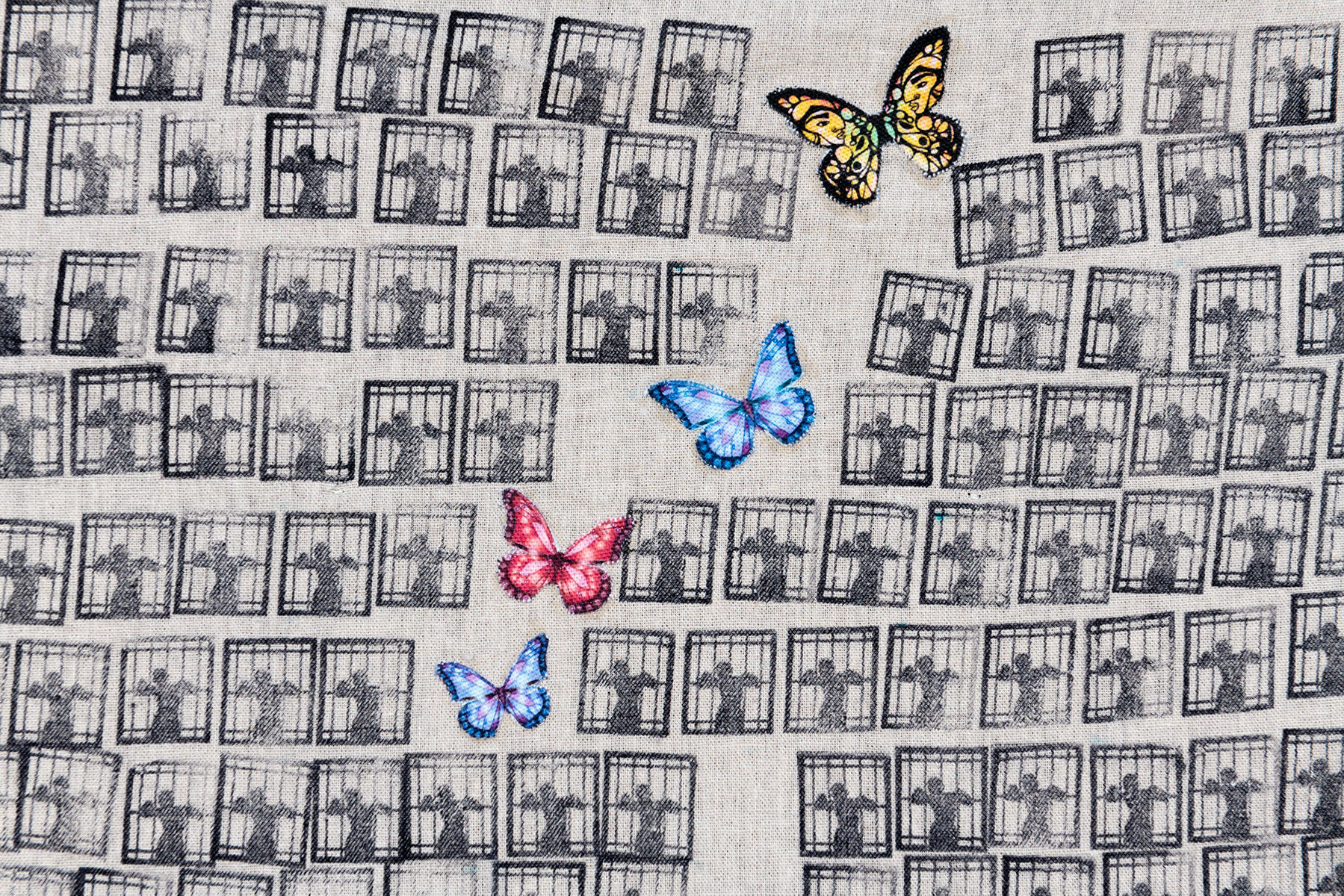Vassar Brings Evocative Quilt Project to Campus, Community
Vassar Brings Evocative Quilt Project to Campus, Community
Activists and artists from 12 U.S. states and Oaxaca, Mexico have created an evocative piece of art that pays homage to the 45,000 men, women and children who were in the custody of U.S. Immigration and Customs Enforcement (ICE) on an average day during 2019. Thanks to the efforts of administrators at Vassar’s Frances Lehman Loeb Art Center (FLLAC) and the Consortium on Forced Migration, Displacement and Education, the 45,000 Quilt Project has been on display on the Vassar campus and several other local venues for several weeks this fall.

(Left to right): Jeff Aman, Chair of the Poughkeepsie Public Arts Commission; Maria Höhn, Professor of History and Director of the Consortium on Forced Migration, Displacement and Education; Tom Pacio, Vassar’s Director of Creative Arts and Institutional Grants Innovation; Matthew Brill-Carlat, the Consortium’s Coordinator of Research and Pedagogy; Student and essayist Olivia Vela Page ’23, and Richard Jones, Collections Manager of Vassar’s Warthin Museum of Geology & Natural History and Laboratory Coordinator for the Department of Earth Science and Geography.
Evoking the famous AIDS Quilt, the 45,000 Quilt Project has 45 individual quilted panels, each with 1,000 marks, created across the continent and stitched together into five large panels in Concord, New Hampshire, where project founder, Glen Ring, works with the Human Rights Group of the Kent Street Coalition.
Tom Pacio, Vassar’s Director of Creative Arts and Institutional Grants Innovation, collaborated on the project with Mary Kay Lombino, FLLAC Deputy Director and the Emily Hargroves Fisher ’57 and Richard B. Fisher Curator; Professor of History and Consortium Director Maria Höhn, Matthew Brill-Carlat, the Consortium’s Coordinator of Research and Pedagogy; and Richard Jones, Collections Manager of Vassar’s Warthin Museum of Geology & Natural History and Laboratory Coordinator for the Department of Earth Science and Geography, who has curated and set up the exhibition at each location.
Höhn said she learned about the exhibit from Valerie Carlisle, a member Abuelas Responden (Grannies Respond), a local immigrant support group that has collaborated on Consortium projects in the past. “Valerie approached us in March, when the campus was about to close (due to the COVID-19 pandemic), to alert us to the project,” she said. “But bringing the 45,000 Quilt Project here became an organic project for faculty, administrators, staff, and students. It’s a wonderful example of how by working together we can create an intellectual discussion about immigration, despite the extra challenges of the pandemic.”

Once the campus re-opened, Jones convinced Höhn and Pacio he thought it was possible to host a “socially distant” exhibit. “I saw it as an opportunity to bring a significant project, like the AIDS quilt, to the campus and larger community,” he said. “I wanted to be able to do something that keeps the fires burning about this issue, since so many people are still being detained.”
Once arrangements had been made to display the exhibit on campus and in the Loeb, Pacio reached out to fellow members of the City of Poughkeepsie Public Arts Commission. Jeffery Aman, chair of the Commission, then arranged for the exhibit to be shown in the lobby of the Family Partnership Center in downtown Poughkeepsie. The exhibit is also being shown at Christ Episcopal Church, Fall Kill Creative Works and the Trolley Barn in the City of Poughkeepsie, and at Marist College and Bard College.
Aman said he was thrilled to be able to bring the project to the Poughkeepsie community. “The arts have a long history of helping people to be informed about history and awareness of important issues, and this is a great example of that,” he said. “It took a lot of people to put this quilt together and just as many to bring it to the public to raise awareness about the injustice and inhumanity we are facing today.”
The exhibit contains an essay by Vassar student Olivia Vela Page ’23, who compared the 45,000 Quilt Project to the role textiles play in protest movements in her native Chile. During a mass rally in Chile last fall, Page wrote, she received images from relatives of many of the protest signs. “From embroidery, to quilts, to fabric collages, to flags, there was no end to what could be made in this unique and unstructured form,” she wrote.
Page said she was immediately reminded of those images from Chile when she viewed the exhibit on the Vassar campus. “Just seeing the beautiful quilts hanging there on the library lawn made me feel a real connection with what’s going on in the world,” she said. “So many people put so much time and effort into this project, and it’s a tangible reminder that these 45,000 people are being detained.”
Pacio said it was gratifying to be a part of the collaborative effort to bring the project to Vassar campus and to other venues in the area. “This project felt very well timed, and I think that is why all the pieces came together as they did,” he said. “During these crazy circumstances, we were able to share this important work with both our campus and local communities. It was a joy to sit on a bench on the library lawn (wearing a mask) and watch people interact with an outdoor art installation; I had almost forgotten what this sort of engagement felt like- it was powerful and generous.”
Support to bring the exhibit to the area was provided by the Andrew W. Mellon Foundation and the City of Poughkeepsie Public Arts Commission.